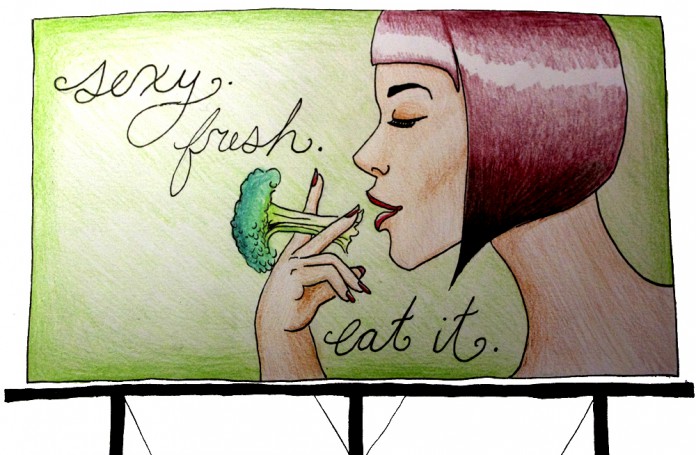Andrea Webber
Illustration by Beth Askins, Layout Editor
The average individual is exposed to about 5,000 advertisements a day, according to Jay Walker- Smith, president of the Marketing Firm Yankelovich. Services and producers are in a brutal war for our attention, and broccoli now wants a piece of it as well.
This classic vegetable is partnering with advertising firm Victor & Spoils in an attempt to revamp its image and reappear on American dinner plates in a big way. With such a large campaign underway for the humble vegetable, as consumers, should we be embarrassed? Broccoli, or any vegetable for that matter, is nothing new. Has our modern American diet become so poor and lacking in these staples that vegetable producers are desperate to remind us of their existence? There is little hope in sugar coating it—the answer seems to be yes.
As reported by the Department of Agriculture and Health and Human Services, only 5 percent of Americans younger than 50 are consuming the recommended amount of vegetables established by the Dietary Guidelines for Americans, and those 50 years and older are only getting 10 to 25 percent. The majority of Americans are eating less than half of the number of vegetables as they should and reception to fruit is not much better. Over half of the fruit consumed is not from the fiber-based fruit but from its juice, which is often categorized with soda due to its high calorie and sugar content. Sadly our neglect has caught up to us. Three years ago, diet topped smoking as the number one threat for disease and death in the United States according to Center for Disease Control and Prevention.
It appears that broccoli’s anticipated comeback is long overdue, but has Victor & Spoils bitten off more than they can chew? Is it really possible for advertising campaigns to reintroduce the long lost vegetables into our fat and sugar laden diets?
Let’s be honest, health messages are always outdone by junk food ads. We are not a society of idiots, just addicts. We may know that produce is beneficial for our health, but the sheer number of messages that we get on a daily basis tends to lean us in the wrong direction. However, there are signs that change may be on its way.
At the first White House conference on marketing food to children this last September, Michelle Obama stated, “The average child watches thousands of food advertisements each year, and 86 percent of these ads are for products loaded with sugar, fat, salt.” Our first lady commended efforts by fruit and vegetable companies to mimic the processed-food industry’s advertising strategies such as using popular characters and celebrities to advocate and promote their products and there are positive results.
Last year, Birds Eye began a marketing campaign using the characters from the popular children’s show “iCarly,” and in turn within two months sales jumped 20 percent. Similar results were seen when Sesame Street conducted a study on children where stickers with Sesame Street characters were placed on apples. Consumption was 27 percent higher on those apples with stickers than the same apples without the stickers.
With these types of results occurring with small scale efforts, a large campaign like the one Victor & Spoils intends to take on is hopeful. Change may indeed be on its way and embracement is strongly encouraged. Last year the University of California, Santa Barbara students shared a proud moment when we were announced the 15th healthiest college nationwide by web-based health resource Greatist. However, that ranking was short lived. This year the same list of the top 25 healthiest college campuses was released, and we failed to make the cut. So as the broccoli crusade sweeps the nation, don’t ignore it. We have a lot of room improvement, and even more potential. Be healthy and eat your veggies, my fellow Gauchos.











